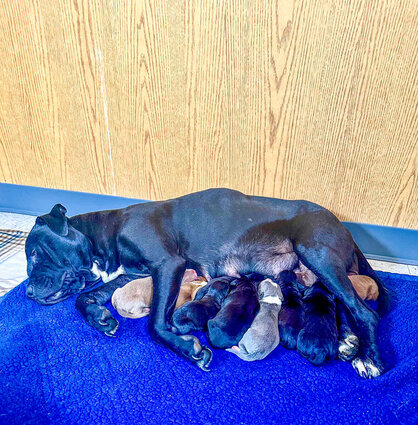Sisters miracle dog brightens lives
Last updated 4/2/2024 at 10:43am

Photo provided
Deschutes County Sheriff's deputies found Ivy in a bad way in the woods. She delivered 10 pups at Brightside Animal Shelter in Redmond. Seven survived and have been adopted.
On a cold December 21, Deschutes County Sheriff's Deputy Jerad Bearson of the Sisters Station found himself on the Cold Springs Road cutoff near Highway 20 in search of a distressed dog. A citizen called it in describing the dog as looking like a black Labrador retriever, pregnant or having recently birthed.
Bearson quickly found the dog, sitting up, guarded. When he approached, the dog became agitated and tried to bite him. Another deputy responded to Bearson's efforts and they enticed the dog to come near their cars, but they couldn't coax the dog into the back seat.
A call was made to Lt. Chad Davis, who heads the Sisters office, and he brought the agency's metal crate. After some more biting attempts the dog put herself into the crate, clearly worn down by her experience. Bearson called Brightside Animal Center in Redmond, and the dog was dropped off at 4 p.m.
The next day at noon, still highly malnourished, and showing signs of a hard existence, she delivered 10 puppies.
"We call her the miracle dog," said Taylor Campbell, Brightside executive director. "It's amazing that she survived, and more amazing that she found the strength to live through the rigors of birthing."
While all 10 pups survived birth, three subsequently succumbed, probably due to her ordeal and having insufficient feeding capacity. The "miracle dog" got better, gained weight, had her long nails and ragged coat tended, was vaccinated and chipped. Her face is scarred from encounters with fences, other animals, or brush.
The pups were weaned after a couple of weeks and could be fostered until eight weeks when the surviving seven could be placed up for adoption. Within four days, all were taken by delighted families.
Mom, named Ivy by the staff in recognition of her near-Christmas arrival, stole the heart of Carol Staropoli, BrightSide's foster coordinator. In her entire life, including six years with BrightSide, Staropoli never had a dog. Cats, yes. But no dog, surprisingly, given the hundreds and hundreds of dogs who have come through the shelter, none stole her heart - until Ivy.
"I just knew at once that this was my dog. I didn't choose her. She chose me," Staropoli said as she thumbed through dozens of photos on her phone of Ivy and her pups. "She's a totally happy dog, and is in charge of me now."
Campbell and Staropoli both said it was the dog's courage and eyes that made her irresistible.
Bearson was delighted to learn of the outcome.
"I've been wondering all this time what happened. What a good ending," he said.
Brightside is a high-save shelter dedicated to providing sheltering, placement, and prevention services to reduce animal homelessness and unnecessary euthanasia.
They have a 97.7 percent animal live-release rate. This rate is calculated by dividing the number of live outcomes (animals leaving the shelter through adoption, transfer to another organization, or return to owner) by all outcomes, not counting animals that died while in the care of the shelter, were lost from the shelter, or that were untreatable and were euthanized at the request of the owner.
In 2022 they took in 679 dogs, 339 of whom were adopted, and 766 cats with 741 adopted. The number of dogs reunited with their owners was 329.
Lost pets are a common occurrence, and a frequent call both to BrightSide and the sheriff's office. Bearson said most dogs are matched with their owner within 24–48 hours and is why they keep kennel crates at the station.
"It's costly to transport pets to Redmond, and takes away time of other calls," Bearson said.
He and Campbell stress the importance of having your pet chipped. A microchip is a small, electronic chip enclosed in a glass cylinder that is about the same size as a grain of rice. The microchip itself does not have a battery-it is activated by a scanner that is passed over the area, and the radio waves put out by the scanner activate the chip. The chip transmits the identification number to the scanner, which displays the number on the screen. The microchip itself is also called a transponder.
It is injected under the skin using a hypodermic needle. It is no more painful than a typical injection, although the needle is slightly larger than those used for injection. No surgery or anesthesia is require. A microchip can be implanted during a routine veterinary office visit.
BrightSide also maintains a helpful lost and found pet page on its website http://www.brightsideanimals.org where you can also find volunteering opportunities and donation options.

















Reader Comments(0)